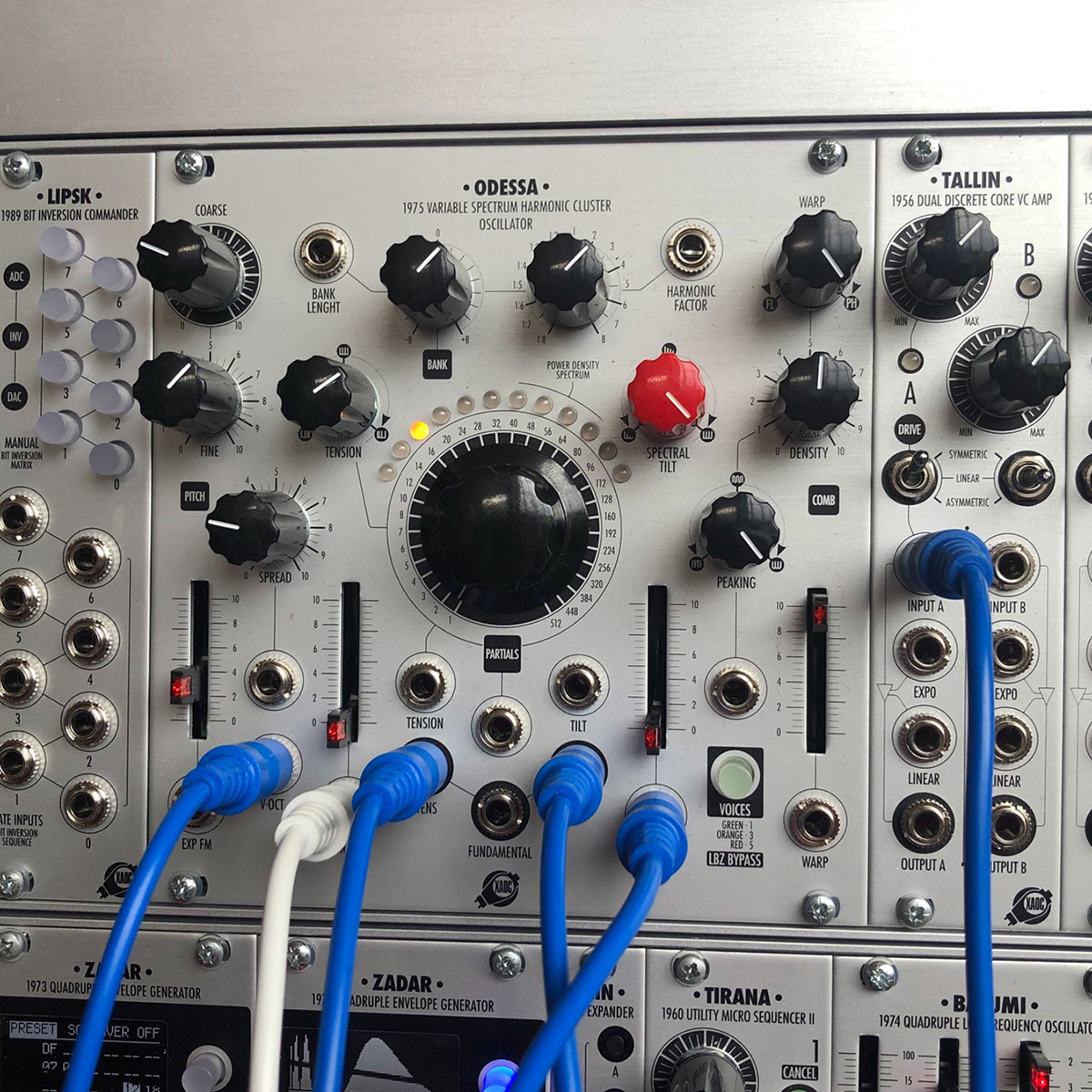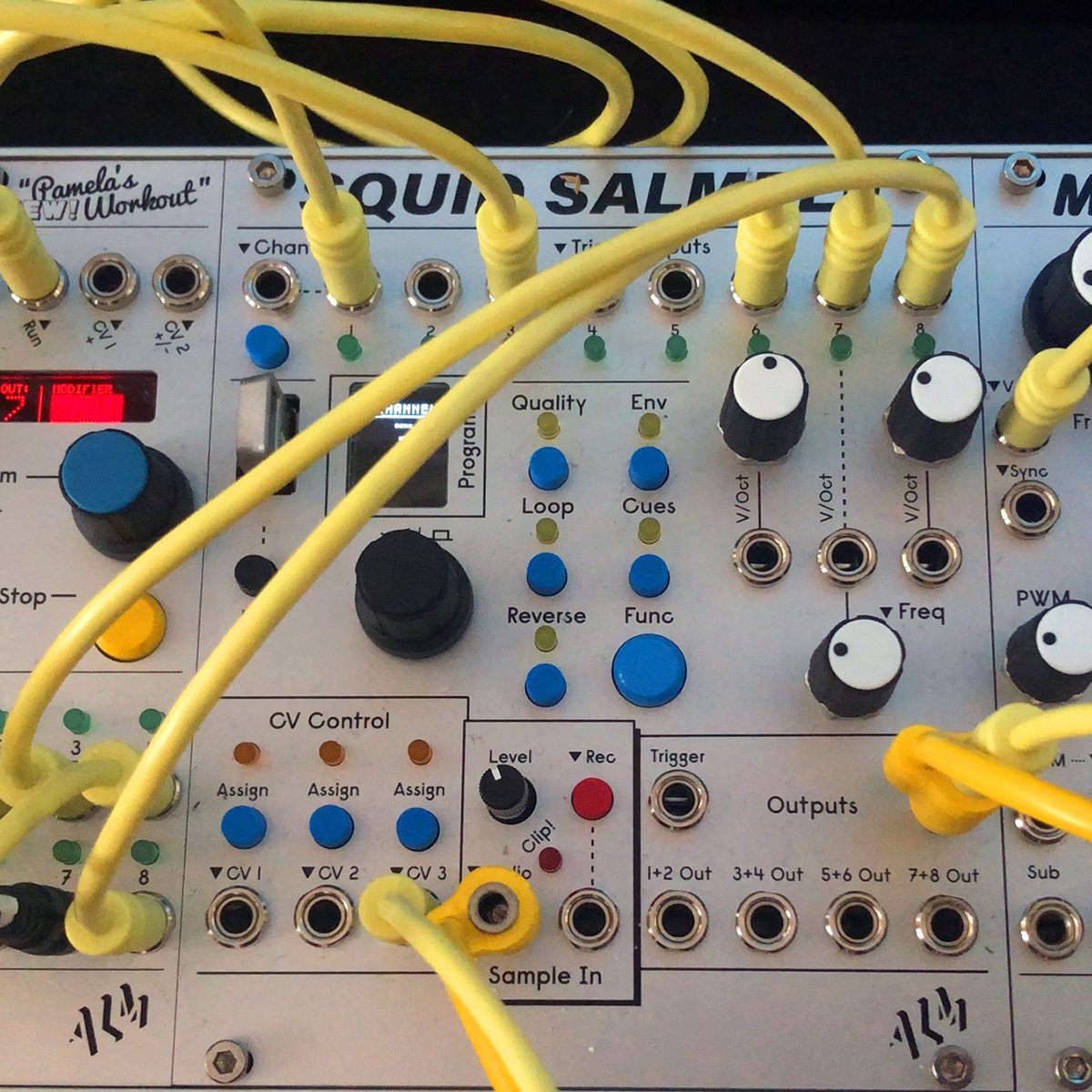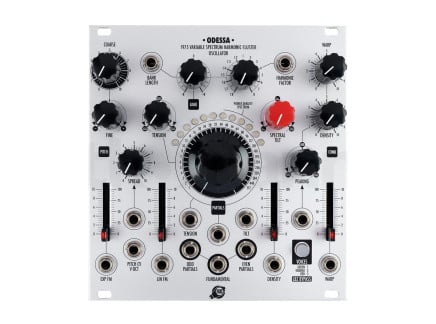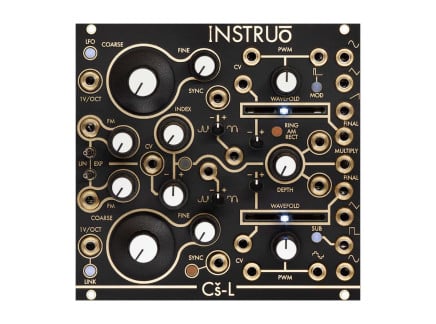The Eurorack universe has steadily grown over the last several years, constantly branching into new directions. Starting from its humble roots as an affordable analog synthesis format, Eurorack now is one of the most progressive platforms in electronic instrument design as a whole—new manufacturers, new technology, and new ways of conceptualizing sound are abundant.
As we approach the end of 2019, we're taking a look back at some of our favorite gear from the past year. There was enough new Eurorack gear that we're breaking it up into several articles—so we're dedicating this one only to sound generators: oscillators, samplers, and the like. And while it's obviously impossible to narrow down an objective list of "the best oscillators, period," we're going to take a quick glance at some of the new Eurorack audio sources that left us particularly excited.
Complex Oscillator Ensemble: Rossum Trident
Looking for a buzzy, detuned triple oscillator stack? Ever wish that your complex oscillator module could be even more complex? Rossum's Trident just might hold the answer. Labeled as a Multi-Synchronic Oscillator Ensemble, Trident is a triple oscillator with loads of modulation, including familiar destinations such as FM and PWM, and more novel controls like Symmetry and Zing modulation.
Each of Trident's oscillators are high-quality analog generators with their own 1V/Oct inputs and individual outputs. As such, it's easy to use them completely independently—or alternatively, each oscillator can be set to track a single 1V/Oct input for Minimoog-like oscillator bank action. Tune up some stacked octaves and fifths and you're well on your way to classic synth leads and basslines.
That said, several internal normalizations make it easy to treat Trident like a highly-refined West Coast-style oscillator as well. Trident is full of opportunities for self modulation: each oscillator has FM and some form of shape modulation (Symmetry or PWM, depending on the oscillator). And then there's Zing modulation—a form of ring modulation based around hard-synced oscillators to create stable mutations of timbre rather than RM's typical clangorous sounds. Capable of producing a huge range of almost wavefolder-like timbres, Zing is one of the most magical parts of the Trident...and combined with each oscillator's individual controls for wave shape, phase, etc., it provides a clever way to achieve intense timbres without the often inharmonic side-effects of FM or AM.
Trident is easily worth the price of entry for three excellent-sounding analog oscillators...and when combined with all of its options for intense modulation, it becomes a no-brainer.
Unapologetically Digital: IME Hertz Donut Mk3
With the third installment of the Hertz Donut, Industrial Music Electronics brings new meaning to the term "complex oscillator." This time incorporating the Mk3 line of preset management, the Hertz Donut Mk3 features robust internal modulation routing. Like all of Industrial Music Electronics' digital products, it is unabashedly digital. This three-operator oscillator (yes, it is three oscillators in one) makes incredibly dense, coldly digital sounds. The Hertz Donut can be used for phase distortion, thru-zero FM, and complex multi-operator FM synthesis.
It features a main master oscillator and two operator oscillators. The main oscillator's timbre and character can be shaped by distorting the phase of a waveform lookup function. Three modeless and continuously variable timbre parameters are freely editable and morphable; phase distortion, umbrage, and resonance. Phase distortion adds break points to the "ramp" wave used to generate the sine. Umbrage is the newest form of the much loved and revered "fractal" distortion from previous versions of the Hertz Donut. Resonance imparts a peak in the waveform and sounds like a resonant filter. Further shaping and sonic modifications can be achieved using the operator oscillators. By default, the operator oscillators are synced to the master oscillator in mathematical ratios. This is not a fixed parameter—ratio locking can be turned off for free running oscillation. Each oscillator can modulate four parameters via the modulation matrix.
The modulation matrix is a complex routing system that can route the internal operator oscillators to modulate the main oscillator, each other, phase distortion, or umbrage. There is also an external input that can be injected into the Modulation Matrix to modulate the main oscillator, either of the operator oscillators, or phase distortion amount. The routing and depth of these modulations is stored internally in the Mk3 preset management system. The master modulation depth is controlled by a modulation knob and VCA. This means you can automate the modulation depth of up to 12 modulation destinations using a single CV source. The Hertz Donut Mk3 does not try to be analog—it has no time for imitations. It is in your face and exactly what only it is.
FM Matrix: Humble Audio Quad Operator
Humble Audio's Quad Operator is a four-operator FM engine in a single Eurorack module. FM is a truly incredible synthesis paradigm—it uses networks of oscillators frequency modulating one another to create tremendously complex timbres ranging from brass and electric pianos to continuously evolving textures. And while the tonal palette of FM is quite broad, it has a bit of a poor reputation—largely because the original FM synths (Yamaha's DX series) provided a particularly minimal interface for controlling a huge number of parameters...and as such, were very difficult to use to their full potential.
Quad Operator aims to address this difficulty by providing a dedicated hands-on control for all of its parameters. It does this by effectively dispensing of the traditional FM concept of an algorithm (a fixed FM path between multiple oscillators) and replacing it with an FM routing matrix, allowing easy creation arbitrary algorithms. And by providing CV inputs for the gain of each of the four operators, dynamic changes to the sound can be source from any modulation source in your system.
Quad Operator also provides CV inputs for each operator's ratio and waveshape, as well as individual outputs for each operator. This has the makings for a remakably complex FM voice or group of voices, especially when paired with clever modulation and use of the Algo algorithm expander. Quad Operator provides maybe the best interface for FM synthesis we've ever seen in any format—Eurorack, keyboard, or otherwise.
Intuitive Additive Synthesis: XAOC Devices Odessa
 The XAOC Odessa at Superbooth 2019
The XAOC Odessa at Superbooth 2019
Additive synthesis is another one of those classic sound generation methods that looks great on paper and often sound amazing...but is super difficult to put behind a useful/approachable user interface. Because effective additive synthesis often involves simultaneously controlling the precise settings of dozens of oscillators and amplifiers (or more!), it can be painstaking to manage...much like FM. A handful of instruments have attempted over the years to provide good additive synthesis interfaces...but as of yet, no standard approach has caught on.
The XAOC Devices Odessa is a strong step in a new direction for additive synthesis. It provides several brilliant macro-level controls to manage the levels and pitch distribution of over 500 oscillators—for everything from swarmy sine wave clusters to brutal metallic textures and bursts of complex noise. With high-level controls for macro tuning (Tension), number of overtones (Partials), and amplitude concentration (Spectral Tilt and Comb parameters), Odessa makes additive synthesis easier and more exploratory than ever before. It also provides exponential and linear FM inputs, which combined with all of the additive controls can bring entirely new meaning to classic techniques.
Odessa is capable of up to five-voice polyphony; within the module itself, this can be used to create deep detuning effects, but when combined with the HEL expander, it enables tonal control of multiple voices for huge chords and sequences. Odessa is no doubt one of the most ambitious and insane-sounding oscillators in any synthesizer.
4MS SWN: Oscillator, or Entire Synthesizer?
The Spherical Wavetable Navigator is a polyphonic wavetable oscillator that uses a sphere of shapes for timbral animation. The wavetables are organized into 27 waveforms that exist in a 3x3x3 grid or sphere and can be smoothly morphed. The geometry of the "sphere" is actually a three-dimensional object that wraps around itself and sort of resembles a donut—a shape called a 3-torus which exists in a conceptual four-dimensional space. You can navigate through the wavetables in three dimensions: longitude, latitude, and depth. If you navigate all the way to the center of the sphere or the edge of any axis, you wrap around and pop out at the other side. If you somehow got inside the wavetable space and walked in a straight line, you would end up at the place you started, facing the same direction.
The SWN features six oscillators that can be tuned together or independently and quantized to scales. Their frequencies can be adjusted by octaves, semi-tones, or by micro-tonal amounts. Each oscillator loads up the same sphere by default, but each oscillator can separately load a sphere of wavetables and be placed anywhere in that sphere independently of the other oscillators.
The SWN also features six LFOs that have independent or global control of speed, phase, waveform, and amplitude. The LFOs go up to audio rates, and when they enter the audio realm their frequency can be adjusted by semitones. The LFOs can also sync to a clock with the ability to divide or multiply the incoming clock. There are three LFO modes—shapes, gates, and triggers. The LFOs can be assigned to open the oscillators' VCAs or the oscillators can drone. The LFOs can be used to modulate the wave position of the oscillators. The buttons at the top of the unit can act as mute buttons, or can be used like keys on a keyboard. This turns the SWN into a six-voice playable polyphonic keyboard in your Eurorack system.
While the SWN comes with 12-factory wavetables, user wavetable spheres can be created using a free program provided by 4ms. You can also record up to 2.5 seconds of audio into the SWN and it derives a wave sphere from the imported audio. The recorded audio can have effects applied to it, including wave folding, decimating, metalizing, low pass filtering, normalization, and smoothing. All settings can be saved and recalled and the SWN can store up to 108 slots of presets. The SWN is a complete instrument in its own right, providing a complex array of functions and control that are unique to it and not found anywhere else.
Polyphony Made Easy: Qu-Bit Chord v2
The Chord v2 is an update of the classic Qu-Bit Electronix module—half the size of the original, retaining all the functionality, and adding much more. It features four voices: root, third, fifth, and seventh, each with individual outputs and a sum output which mixes the voices together. The Chord V2 includes a selection of eight banks of waveforms, including traditional waveforms, a sawtooth wave through a low pass filter, FM, distorted, voice, square with pulse width control, video game, and organ tones. Or if that's not enough, you can load your own waveforms using an SD card.
You have control over inversion and quality, which together define the relationship between the third, fifth, and seventh outputs in relation to the root. The 1V/Oct inputs can be quantized to major, minor, or chromatic scales, with the ability to also remain unquantized. There are four modes that determine how the individual voices behave. In the default mode, the front panel controls and CV inputs act as they are marked on the panel. In melody mode, the 7th chord tone is decoupled from the triad and can be sequenced independently. In free polyphonic mode, all voices run independently and can be sequenced entirely independently. In unison poly mode, the voices are tuned together but have their own v/oct inputs. You also have the ability to store and recall custom chords on the SD card, with the ability to create chords that exist outside the traditional Western twelve-tone equal-tempered scales. The ability to create microtonal chords is a great feature that was not available on the original and provides new realms of chords and tunings to explore.
The Chord V2 is an update to a module that helped define the standard for Eurorack chord modules. It builds and improves on the features and limitations that were present on the original, and has transformed into one of the most captivating and powerful modules of the year. If you want to make harmony-oriented music with a Eurorack system, Chord is an obvious and powerful choice of sound source.
Not Really an Oscillator But That's Okay: ALM Squid Salmple
 ALM's Squid Salmple at Superbooth 2019
ALM's Squid Salmple at Superbooth 2019
The ALM Busy Circuits Squid Salmple is an eight-channel audio and CV sampler. Samples can be loaded from a USB drive or can be recorded into the module. The record function can be automated with a gate or trigger input. Pressing the record button will generate a trigger at the output, which can be used to trigger an envelope of the sound you want to record. The input takes modular level or line level signals with the ability to set the level of the incoming audio or CV. Samples are loaded in banks of eight samples. There are five outputs, one mix output and four pairs of the channels, which are DC coupled and can output CV as well as audio.
You have the ability to edit the bit rate, speed/pitch, level, and decay envelope of each of the samples. Channels six, seven, and eight have pitch control on the front panel and 1V/Oct inputs. The 1V/Oct inputs can be quantized to semitones or octaves. The samples can be looped and played back without the need for external triggers or in conjunction with external triggers. Samples can play forwards, backwards, or forwards and then backwards. The cue points of the sample can be edited with control of start, end, and the loop point. The CV control section includes three-assignable CV inputs. These can be routed to any of the controls that are available to be edited. Unfortunately you don't have the option to CV select the samples of the individual channels...the Squid Salmple was designed to do other things though, and does plenty of them.
The Squid Salmple has the ability to record or load audio or CV samples that can be further edited, manipulated, mangled, and transformed into entirely new entities. Modeled after early rack-mount samplers, the Squid Salmple pushes this concept to its limits. All the ALM Busy Circuits modules seem to do this: they take ideas that already exist in modular and push them to new places with fun and exciting features and interfaces.
Honorable Mentions
There were a lot of new oscillators this year, so many of which are worth discussion. The list above are just some of our personal favorites from the year, but we'd be remiss to not quickly mention some other amazing modules as well.
The Supercritical Demon Core Oscillator is another heavily-discussed module that made its first appearance this year. Supercritical came out the gates promising Demon Core as an answer to modular polyphony—also providing staggeringly huge supersaws and more. If you're looking to build a polyphonic synth with Eurorack modules, Demon Core is one of the biggest-sounding options out there. With up to 16 oscillators behind a single panel, Demon Core just sounds straight up huge.
1010 Music presented the newest in their line of touchscreen-based Eurorack modules—the Waverazor, produced in collaboration with plugin designer MOK. Waverazor uses a patented oscillator design based around wave slicing: a means of splicing together multi-segment waveforms out of pre-defined waveshapes. With a touchscreen interface and tons of CV inputs, Waverazor is a sure and easy way to create all manner of biting, edgy new sounds.
WMD's Crucible isn't really an oscillator, but it's definitely one of the most interesting sound sources released for Eurorack synths this year. Based around a complex waveguide algorithm, Crucible was designed to produce physically-modeled cymbal sounds with an astonishing level of realism. And it absolutely works—I've been fooled more than once by its dynamic pings and chokes. Create cymbal sounds that change in size and shape with remarkable clarity...Crucible is incredible.
As of the time of writing, we haven't quite gotten our hands on the Steady State Fate ZPO—but if the Stereo Dipole is any indication of its quality, we're in for a treat once they arrive. ZPO (Zero Point Oscillator) is an insane-sounding analog VCO, providing enough options for timbral alteration that it can easily go from smooth, thick analog tones to devastating pseudo-digital mayhem in no time. It provides its own unique approaches to thru-zero modulation and waveshaping, and a huge number of CV inputs mean that evolving tones are just an LFO away. No doubt we'll take a closer look at ZPO once it arrives at our shop...
And then there's the Endorphin.es Godspeed+...and Soundforce's DCO...and Dove Audio's Waveplane...and then there are all the filters and effects that can be used as astonishing sound generators in their own right (we're looking at you, Mimeophon, QPAS, and Stereo Dipole!). In short, 2019 saw the release of tons of excellent oscillators, any of which could easily become the basis of an awesome Eurorack setup.
We were excited to see so many manufacturers tackle so many concepts notoriously difficult to implement in modular synths. We now have more ways to explore FM, additive synthesis, phase distortion, vector synthesis, wavetable synthesis, and more. It seems as if innovation in Eurorack is still healthy and blossoming, and we can't wait to see what 2020 will hold.












